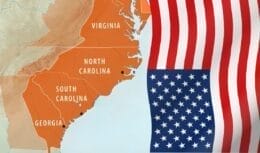
Railway Bridge over the São Francisco River, a 2,9 km landmark in Bahia, promises to revolutionize regional transport and economy, integrating the 1.500 km West-East Integration Railway and strengthening national connections.
In the picturesque landscape of the Northeast, Bahia stands out with the recent inauguration of the Railway Bridge over the São Francisco River, a structure with 82 pillars and almost three kilometers long, joining Serra do Ramalho and Bom Jesus da Lapa. This landmark not only symbolizes the union of two locations with distinct natural and cultural riches, but is also a crucial section of the ambitious West-East Integration Railway (FIOL), which covers more than 1.500 kilometers.
Designed to strengthen transport and economic development, FIOL connects the interior of Bahia to ports on the Atlantic, crossing territories to Tocantins, where integration with the North-South Railway is expected, boosting national trade. Construction of the bridge, which began in 2015, faced technical and environmental challenges, overcome by innovative methods such as successive balance, a technique nationally developed in the 1930s.
Railway Bridge over the São Francisco River is significant for the region
In addition to being an engineering feat, the bridge represents a significant advance in the region's infrastructure, promising to boost tourism and the local economy. The work, which cost R$135 million, illustrates the capacity to execute large projects in Brazil, with a predicted positive impact in terms of reducing logistics costs and CO2 emissions. Thus, the Railway Bridge over the São Francisco River is more than a construction; It is a bridge to the future, symbolizing progress and unity in the heart of the Brazilian Northeast.
The Railway Bridge over the São Francisco River, strategically located between Serra do Ramalho and Bom Jesus da Lapa, not only connects two cities with unique cultural and natural heritage, but is also part of a larger infrastructure project that aims to improve logistics and the economy from the Brazilian Northeast. This project, the West-East Integration Railway (FIOL), extends for 1.526 km, crossing vast areas of fertile land and mountains, and plays a crucial role in transporting heavy loads, including grains, ores and industrial products, to the ports on the Atlantic coast.
Construction of the bridge, which began in 2015, stood out for its use of advanced engineering techniques, such as the successive balance method, which allows the construction of large spans without temporary support, reducing costs and execution time. The work overcame several challenges, including geographical and environmental aspects, thanks to innovative engineering that incorporated methods such as the continuous propeller and the compressed air tube to establish solid foundations.
West-East Integration Railroad

The West-East Integration Railway (FIOL), one of the most anticipated infrastructure projects in Brazil, extends for approximately 1.527 km, connecting Ilhéus, on the coast of Bahia, to Figueirópolis, in Tocantins. This railway is designed to be a crucial route in the country's transport network, improving access to ports and markets for the interior producing regions.
The FIOL project is a significant initiative, with robust investments that reflect its strategic importance. Construction is divided into several stages, with the section from Ilhéus to Caetité (FIOL 1) being one of the most advanced. The total estimated cost for this section is around R$8,9 billion, which covers the first two phases of FIOL. The company Bahia Mineração SA (Bamin), under the umbrella of the Eurasian Resources Group, won the auction for the FIOL 1 section, committing to invest approximately R$3,3 billion to complete the works, of which R$1,6 .1 billion is earmarked specifically to finalize FIOL XNUMX.
Construction is being carried out by several renowned companies in the infrastructure area, including Crec-10 and Tiisa, which bring experience and technical expertise to the project. FIOL serves multiple purposes, not only improving transport logistics and facilitating the flow of products such as iron ore and agricultural commodities, but also stimulating economic development. The railway is expected to bring a significant reduction in transportation costs, which in turn could promote more equitable income distribution and fuel growth in several regions of Brazil.
In addition to the economic benefits, FIOL has an important role in environmental and social sustainability, as it is expected to contribute to the reduction of CO2 emissions, reducing dependence on road transport, which is more polluting. This transition to a more efficient and less polluting means of transport is vital for the sustainable development of the region and the country, in line with sustainable development goals and efforts to reduce negative environmental impacts.












